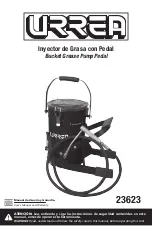
6
Installation and
Start-Up Procedures
Each water conditioner includes 8’ of drain line.
1. Placement
Place your appliance in desired location. Turn off electricity and water
supply to water heater. Make sure inlet/outlet and drain connections
meet the applicable local codes. Check arrows on valve to be sure
water flows in proper direction.
See Figures 1, 2, & 3
CAUTION: DO NOT PLUMB APPLIANCE IN BACKWARD.
2. Connecting Water Lines
Lift and remove the valve cover. Attach the water lines to the in and
out connections. Do not over tighten connections on the plastic
threads. Check inlet connection and outlet connection to be certain
water flows in the proper direction. (As you face the front of the
appliance, the inlet is on the left and the outlet is on the right.) See
Figure 2
3. Drain Line
The drain line must be a minimum of
1
⁄
2
" I.D. tubing and should make
the shortest run to a suitable drain. The drain line may be elevated
up to 8 feet from the discharge on the appliance as long as the water
pressure in your system is 40 psi or more. If drain line is 25’ or lon-
ger, increase drain line to
5
⁄
8
" I.D. Also, the end of the drain line must
be equal in height or lower than the control valve. See Figure 1.
4. Flushing
Before placing your appliance in service, it is very important to flush
the cold water lines of any debris. Turn on water supply, open the
nearest cold water tap and let the water run for 2 to 3 minutes until
the water flows clear. Then put the by-pass in the Service position.
See Figures 4 through 6.
5. Check Leaks
Close faucet and check for leaks. If leaks are found, turn off main
water supply and open the nearest cold water faucet to depressurize
lines. Close faucet to eliminate siphoning action. Repair leaks. Turn
on water supply and electricity to water heater.
Place the bypass valve in the Service position. See Figure 6.
6. Connect Overflow Line
The overflow line is used to direct excess water to a floor drain if the
brine tank fills with too much water, or the appliance malfunctions.
The overflow line must end at a drain that is at least 3" lower than the
bottom of the overflow fitting. It is a gravity line and cannot be run
overhead. See Figure 7.
7. Complete The Installation
Open a cold water tap and allow the appliance to flush for 20
minutes or until approximately 72 gallons has passed through the
appliance per NSF requirements.
8. Plug In Transformer
See Figure 8.
9. Water Testing
The water conditioner, like any other appliance, requires correct
installation and setting for optimum performance. To ensure proper
settings, you need to obtain an accurate water test.
Do this as follows:
For municipally supplied or “City” water, call your water utility compa-
ny. Ask them the hardness, iron content and pH levels of your water.
For well water, have a sample of your untreated water tested for
hardness, iron and pH. To find a facility to test your water sample,
check your Yellow Pages under Water Analysis or Water Testing.
If you feel you have an abnormal amount of iron, be sure to use salt
with an iron-cleaning additive.
10. Adding Water & Salt
Be sure to remove any packaging or installation materials before
adding salt. Next, add no more than 3 gallons of water to the brine
cabinet. Then add salt to the brine cabinet, wait 2 hours then push
the REGENERATE button and hold for 5 seconds. A regeneration
cycle will begin and continue for approximately 27 minutes. After the
first regeneration, your appliance will automatically refill the correct
amount of water in the brine cabinet. See Figure 9.
11. Refill Salt
Refill Salt when the salt level drops below the water level in the brine
cabinet. Always keep salt above water level. See Figure 9.
CAUTION! Failure to install, operate and maintain your water
treatment appliance as instructed will VOID the product limited
warranty.






































